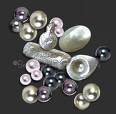

Rarity: Natural pearls are very rare however cultured farm-grown pearls are easily sourced. Round pearls are actually very rare, which explains why the more round a pearl is, the higher in value it will be. Some shells can have flattened sides due to being pushed up against the shell whereas others may have ridges from the pressure around them.

The shape is formed by many factors of the organism such as the size of its nucleus and the position of the pearl. Other colours include black, silver, green, pink, green and many more - these colours are determined by the certain organism which produces the pearl.Īppearance: Pearls can be found in a variety of shapes and sizes which make them a really interesting gemstone. The most popular colour choice is white and cream, which is mainly associated with a bride on her wedding day but also classic jewellery designs too. More facts about pearlsĬolour: Natural and cultured pearls come in a whole range of beautiful colours. This is why we culture them! It is still a natural process, however it has been instigated by humans. Naturally created pearls are extremely rare as only a small percentage of mussel will ever produce a pearl – it is said that one in ten thousand molluscs naturally produce gem-quality pearls. A cultured pearl is created by placing a piece of mantle tissue inside the mollusk which then deposits layers of nacre around the nucleus, dissolving it and creating the pearl. Nearly all of the pearls on the market today are cultured.

This process continues, layer upon layer, until the iridescent pearl is formed. The mollusk begins to protect itself from irritation by covering the piece of grit or sand with layers of nacre - the mineral that the mollusk's shell is made from (also known as mother-of-pearl). A pearl is formed when there is something irritating the mantle folds inside the mollusk - this is normally something such as a piece of grit or sand that has made its way inside. It is made of calcium carbonate which has been deposited in concentric layers. A pearl is produced in the soft tissue of a living shelled mollusk - such as an oyster or a mussel.


 0 kommentar(er)
0 kommentar(er)
